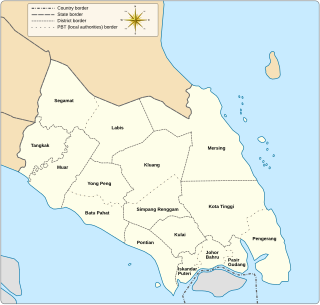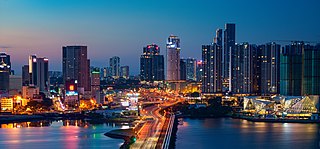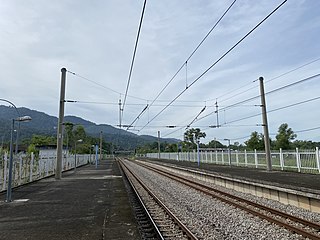Related Research Articles
TLP may refer to:
Keretapi Tanah MelayuBerhad (KTMB) or Malayan Railways Limited is the main rail operator in Peninsular Malaysia. The railway system dates back to the British colonial era, when it was first built to transport tin. Previously known as the Federated Malay States Railways (FMSR) and the Malayan Railway Administration (MRA), Keretapi Tanah Melayu acquired its current name in 1962. The organisation was corporatised in 1992, but remains wholly owned by the Malaysian government.

Pasir Gudang is a city in Johor Bahru District, Johor, Malaysia. The main industries are transportation and logistics, shipbuilding, petrochemicals and other heavy industries, and oil palm storage and distribution, which is located in Johor Port and Tanjung Langsat.

The Johor Bahru District is a district located in the southern part of Johor, Malaysia. The heavily suburban/suburbanizing district covers an area of 1,063.97 km2 (410.80 sq mi) and has a population of 1.71 million. The district capital is Johor Bahru City and the administrative capital is Iskandar Puteri City. The district borders Pontian District on the west, Kota Tinggi District on the east, Kulai District on the north and Straits of Johor to the south. The urban centres are divided into the cities of Johor Bahru, Iskandar Puteri and Pasir Gudang.

Malaysia Marine and Heavy Engineering Holdings Berhad is a Malaysian owned shipbuilding and heavy engineering industries company. It was formerly known as Malaysia Shipyard and Engineering Sdn Bhd. MHB has been long involved in oil and gas engineering and construction works.

Masai is an area in Pasir Gudang, Johor Bahru District, Johor, Malaysia, and is the oldest neighbourhood of Johor Bahru town. It is located 25 kilometres from the Johor Bahru city centre. Masai is located on route J10 which leads to Kong Kong, a fishing village along Johor River. The main access roads to Masai are Jalan Masai Lama (J10) and Pasir Gudang Highway.
Johor Port is a port in Pasir Gudang, Johor, Malaysia, built in 1977. It is an integrated multi-purpose port facility providing bulk cargo, container and general cargo services. It is the world's largest palm oil terminal and ranks third globally in terms of LME cargo volume.

An oil terminal is an industrial facility for the storage of oil, petroleum and petrochemical products, and from which these products are transported to end users or other storage facilities. An oil terminal typically has a variety of above or below ground tankage; facilities for inter-tank transfer; pumping facilities; loading gantries for filling road tankers or barges; ship loading/unloading equipment at marine terminals; and pipeline connections.

Pasir Gudang Highway, also known as Federal Route 17, is a highway in Johor Bahru District, Johor, Malaysia that connects Tampoi North in the west to Pasir Gudang and Tanjung Langsat in the east. Pasir Gudang Highway is a four-laned highway, unlike the wider Skudai Highway which has six lanes. Many cargo trucks travel along the highway daily. Pasir Gudang Highway became the backbone of the road system linking Johor Bahru to Pasir Gudang before being surpassed by the Senai–Desaru Expressway, SDE 22, and the Johor Bahru East Coast Parkway 35.

Pengerang is a municipality in Kota Tinggi District, in the Malaysian state of Johor. It was established in 2017. It is home to the Pengerang Integrated Petroleum Complex (PIPC), a major hub for the oil and gas industry in the state.
Tanjung Langsat is a main industrial area and port in Pasir Gudang, Johor Bahru District, Johor, Malaysia.

MISC Berhad was incorporated in 1968 as Malaysia International Shipping Corporation Berhad and is the leading international shipping line of Malaysia. In September 2005, Malaysia International Shipping Corporation Berhad adopted its present corporate identity and changed its name to MISC Berhad. Its main shareholder is Petroliam Nasional Berhad (Petronas), the national oil conglomerate of Malaysia. The principal business of the corporation consist of ship owning, ship operating, other shipping related activities, owning and operating of offshore floating facilities as well as marine repair, marine conversion and engineering and construction works. With a fleet of more than 120 vessels and a combined tonnage of more than 13,000,000 DWT.

Serangoon Harbour is a harbour in Singapore located between the mainland island of Singapore and Pulau Ubin.

The Port of Sines is the largest artificial port in Portugal, and a deep water port, natural backgrounds to -28 m ZH with specialized terminals that allow the movement of different types of goods. Besides being the main port on the Atlantic seaboard of Portugal due to its geophysical characteristics, is the main gateway to the energy supply of Portugal: container, natural gas, coal, oil and its derivatives. Construction started in 1973 and it came into operation in 1978. The Port of Sines Administration was created on 14 December 1977. The port operates 365 days a year, 24 hours a day, providing services such as: control of maritime traffic; pilotage, towage and mooring; access control and surveillance; drinking water and bunkers; prevent accidents/pollution; repairs on board or ashore. The Port of Sines is located at 37° 57′ north latitude and 08° 52′ west longitude, 58 nautical miles south of Lisbon.

Port Botany is a deepwater seaport located in Botany Bay in Sydney, Australia. The port is dominated by trade in containerised manufactured products and, to a lesser extent, bulk liquid imports including petroleum and natural gas. It is one of Australia's largest container ports and is administered by NSW Ports which entered into a 99-year lease agreement with the Port Authority of New South Wales in May 2013.

The Nigerian Ports Authority (NPA) is a federal government agency that governs and operates the ports of Nigeria. The major ports controlled by the NPA include: the Lagos Port Complex and Tin Can Island Port in Lagos; Calabar Port, Delta Port, Rivers Port at Port Harcourt, and Onne Port. Operations of the NPA are carried out in affiliation with the Presidency of (Nigeria) and the Nigerian Shippers' Council. The Head office of the Nigerian Ports Authority is located in Marina, Lagos.

Iskandar Malaysia, formerly known as Iskandar Development Region (IDR; Malay: Wilayah Pembangunan Iskandar) and South Johor Economic Region (SJER), is the main southern development corridor in Johor, Malaysia. It was established on 8 November 2006. Iskandar Malaysia, which is formed by major cities such as Johor Bahru, Iskandar Puteri, Pasir Gudang, together with their surrounding areas, is Malaysia's second largest urban agglomeration with a population of 2,500,000, after Greater Kuala Lumpur.

The West Coast railway line runs from Padang Besar railway station close to the Malaysia–Thailand border in Perlis to Woodlands Train Checkpoint in Singapore. It is called the West Coast railway line because it serves the West Coast states of Peninsular Malaysia.
Lotte Chemical Titan Holding Sdn Bhd engages in the ownership and operation of polypropylene plants, polyethylene plants, ethylene crackers, and aromatic plants. It offers high-density polyethylene (HDPE), Low-density polyethylene (LDPE), and Linear low-density polyethylene (LLDPE) for various kinds of applications, room household goods to automotives products. The company also manufactures low-density polyethylene for injection molding for cosmetic containers, bottle closures, and food containers, and is based in Pasir Gudang, Malaysia.

Pengerang Integrated Petroleum Complex (PIPC) is a megaproject development in Pengerang, Kota Tinggi District, Johor, Malaysia. It spans over an area of 80 km2 and will house oil refineries, naphtha crackers, petrochemical plants, liquefied natural gas (LNG) terminals and a regasification plant upon completion.
References
- ↑ Khalid, Nazery; Ang, Margaret; Cory Abu Hasan, Elvia (22 September 2011). "Assessing the Issues, Challenges and Prospects of Selected Secondary Ports in Peninsular Malaysia" (PDF). Maritime Institute of Malaysia. pp. 17–20. Retrieved 30 March 2018.